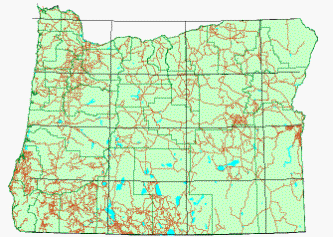

State of Oregon
Transverse Mercator Projection
Central Latitude: 41.75
Central Longitude: -120.5
The Transverse Mercator projection is also known as the Gauss-Kruger projection or the Gauss Conformal projection. This projection is cylindrical and conformal. In this projection, scale is constant along any straight line that is parallel to the specified Central Longitude. Scale increases with distance from the Central Longitude. Distortion is minimal near the center of the projection and increases dramatically with distance from the center. Distortion is considerable when projecting coordinates that fall within a few degrees of the poles. This projection is useful primarily for mapping small regions no more than a few degrees across, particularly high-aspect regions (regions taller than they are wide). A limitation of this projection is that coordinates at or near the poles cannot be projected. An additional limitation is that regions larger than a quadrant (e.g. having greater than 90 degrees extent either vertically or horizontally) result in portions of the projected image folding over each other due to constraints of the mathematical formulas used. The projection is best used with areas that are no greater than 30 degrees wide or tall, and preferably with areas that are much smaller.
|
Parameter |
Description |
|
Name |
Specifies the units used in the map. |
|
Scale |
Specifies the unit scale of the projected map, relative to meters. For example, a scale of one means one unit in the projected map equals one meter; a scale of two means two units in the projected map equal one meter; etc. |
|
False Easting |
Specifies the false easting, or horizontal offset, of the projected coordinates, in meters. False Eastings and False Northings are added to the underlying "projected" coordinates as a way to arbitrarily offset their internal XY coordinates after the projection. Unless you have a reason for using these offset values, do not use them. These values do not affect the latitude/longitude coordinates for the map, only the internal coordinates used to plot the map on the screen. If you use False Easting and False Northing offsets for a map, any subsequent boundaries you append to the map must also use these same offsets if you want the imported boundaries to be drawn in the correct relative position to the existing boundaries. |
|
False Northing |
Specifies the false northing, or vertical offset, of the projected coordinates, in meters. See above. |
|
Central Scale Factor (KO) |
Specifies the central scaling factor for the projection. This value is often set to 1.0, but may be set to another value for specific applications. |
|
Central Longitude |
Specifies the central longitude of the projection in degrees. The Central Longitude value typically should be defined as the longitudinal center of the map you are going to produce. |
|
Central Latitude |
Specifies the central latitude of the projection in degrees. The Central Latitude value typically should be defined as the latitudinal center of the map you are going to produce. |
See Also
Introduction to Map Projections
Characteristics of Projections
Latitude/Longitude Coordinates
Latitude/Longitude in Decimal Degrees
Using Scaling to Minimize Distortion in Latitude/Longitude Projects